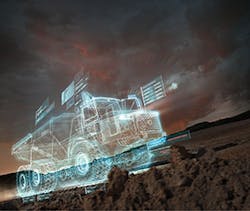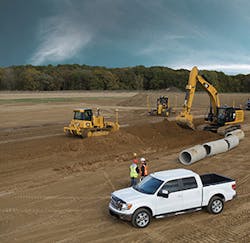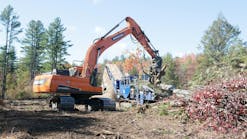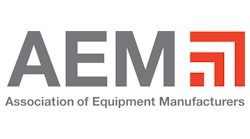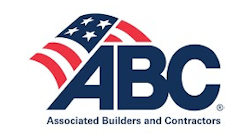Telematics systems are no longer novelties. Grading and excavation contractors have long relied on these systems to provide them with important data about how much fuel their construction vehicles are consuming, how much time their machines have spent idling at job sites, and how many work hours they’ve logged.
Those contractors who operate sizable fleets of graders, excavators, and other vehicles all manufactured by the same company can easily log onto a single portal to access this information from all of their telematics-equipped machines.
But those contractors whose fleet is made up of vehicles from several different manufacturers? Accessing the telematics data from their equipment becomes more of a challenge. That’s because contractors have to log onto one website to pull telematics data from their Caterpillar machines, another to get it from their Volvo vehicles, and yet another to access information from their John Deere graders and excavators.
Fortunately, telematics experts say that the first steps to resolving this problem have already been taken. Two key trade organizations—the Association of Equipment Manufacturers and Association of Equipment Management Professionals—have made a draft version of a new application programming interface (API) available for download.
This new standard—the API standard version 2.0—allows contractors to access telematics data from one single log-in website, even if their fleet includes vehicles made by several different manufacturers.
A Needed Change
Critical. That’s the word Nick Redd uses to describe how important the API standard version 2.0 will be to contractors. Thanks to this standard, contractors and machine operators will now be able to tap the full value of their machines’ telematic systems, says Redd, marketing supervisor for Caterpillar Inc.
“As customers look to manage their fleets, they want to do it from one system,” says Redd. “They want to manage everything on the job site with a single solution. The ability to get data from all assets regardless of manufacturer is really a foundational element for effectively managing a job site.”
And that, at its most basic, is what the new API standard is designed to do. The goal is to make it as easy as possible for customers to access and manage important information about how all their machines—no matter who manufactures them—are operating. But that’s only part of the mission. The new API standard will also make it easier for the manufacturers of telematics technology to make this key operational data available to end users.
Redd says that the challenge today is that the makers of telematics systems offer their own applications that allow their customers to access data about how much fuel their machines are burning, how long they’ve been idling, or how much dirt they’ve moved. Contractors who run machines made by a variety of manufacturers have to mine this data, then, from several different applications.
Redd says that this is inefficient, and that end users are tired of jumping from app to app to determine how efficiently their machines and their entire job sites are operating.
The new API standard will allow end users to pull data from manufacturer A, B, and C from one single application.
“The contractors don’t want to deal with inefficiency any longer,” says Redd. “And the new standard will help eliminate the inefficiency that exists today.”
The Association of Equipment Manufacturers and the Association of Equipment Management Professionals already have some experience in crafting an API standard for telematics. Since 2011, the associations have offered version 1—and then, later, version 1.2—of such a standard.
Those earlier standards, though, were not complete solutions, mainly because they only cover the most basic of data: information such as a machine’s location, the hours it worked, the numbers on its odometer, and the amount of fuel it consumed.
Version 2.0 of the API standard—the draft version of which the associations just recently made available to contractors and other end users—is a step forward. As Redd says, it makes 19 different data points available to users. Let me point out one of the most important of the new additions. Version 2.0 of the API standard includes idle time, which will allow operators to determine how long the machines on their job sites have been idling no matter how many different manufacturers’ graders and excavators they are using.
Idling time, of course, is important. The longer heavy equipment sits idling without actually working, the less revenue the machines generate, costing contractors money. If contractors can quickly determine which machines on which job sites are spending too much time idling instead of working, they can make better decisions about where to place these machines. They can then send graders or excavators to those job sites on which they’re most needed and on which they won’t be spending as much time idling.
The availability of the draft version 2.0, though, doesn’t mean that the telematics industry will stop evolving. The version available now by the associations remains a draft version, so changes will probably be made to it.
And even once version 2.0 of the API standard (end users can find the draft standard at http://bit.ly/1V8sOCQ) is tweaked, much work will still need to be done to boost the efficiency of telematics systems.
Redd says that today there is no process to determine which manufacturers are adhering to the API standard. To help address this issue the goal is for the API standard version 2.0 to become part of the ISO.
“We want a process that will make sure that those who say they support the standard do actually support it in every detail so that it is as easy to work with as possible,” says Redd.
Redd says that the goal of the Association of Equipment Manufacturers and Association of Equipment Management Professionals is to have the latest API standard become part of the ISO process by the end of 2015. He says that work is moving along on track to hit this deadline.
But even once that occurs, it will be up to the manufacturers of telematics equipment to make data from their machines available to customers.
“Once we have the standard in place, it’s just that,” says Redd. “It’s a standard. Customers won’t have the opportunity to leverage the benefits it can provide until the manufacturers support it within their telematics systems. There will likely be a lag from the time the standard is officially released until there is a critical mass of manufacturers supporting it. However, once they do, customers will be able to take advantage of it immediately.”
The ability to monitor idle-time data from several different manufacturers’ machines from one application is the most important benefit of the new standard, says Redd.
If contractors discover that a machine on one job site is spending 80% of its time idling, they can move that vehicle to a second job site where it can be more active.
Redd says that he doesn’t think contractors will take too long to adapt to the new standard. Contractors have already discovered the benefits of telematics, he says.
“This technology is already installed in most of the vehicles in their fleets already,” says Redd. “They are hearing the same success stories of other contractors who are using telematics to work more efficiently. They have already been educating themselves on how beneficial this data can be for them. There will be a learning curve, but I don’t expect it to be a long one.”
An Industry Ready for Change
Liz Quinn, product marketing manager with John Deere’s WorkSight technology program, says that contractors are ready for an API standard that lets them easily integrate data from multiple sources and manage the numbers they need to efficiently manage their equipment.
“It’s a commonly voiced customer need. They want to view the numbers from all of their assets in the same place,” says Quinn. “I view the standardization of API as a first step. It’s a foundational step to be able to actually integrate data from multiple sources and still make sense of it, an input into the development of a dashboard that allows you to analyze data from multiple brands of equipment. Contractors want the ability to compare and manage their assets from a common operating model.”
As product marketing manager, Quinn holds several focus groups every year. At every one of these groups, she says, end users tell her that they are desperate for a way to analyze their machines’ idle time, fuel consumption, trouble codes, and work hours from one central application.
That’s what the API can enable if the contractor and their IT manager take the steps to integrate that standardized data into their system of choice.
“I don’t have one conversation or focus group where the need for a standard is not voiced, and not voiced with enthusiasm and passion,” says Quinn. “They want to know how we can make this happen.”
Having original equipment manufacturers (OEMs) provide a standardized data feed, though, is just the first step in allowing contractors to analyze information from all machines through one application, says Quinn. It’s an important step, but far from the final one.
Once the OEMs provide the standardized data feed, companies such as third-party portal providers and suite-management software firms must grab that API data feed and write their own code to integrate the data into their systems, says Quinn.
For instance, John Deere is making the API accessible at http://developer.deere.com. It is then up to IT departments or vendors to connect their customers’ data to the common system of their choice, says Quinn.
How far, then, is the industry from a time in which the majority of contractors and owners will be accessing telematics data for all of their machines from one application? Quinn says that the industry will be closer to this goal when the API standard is available than ever before.
“That holy grail is not as far away as it was before the standard,” says Quinn. “My crystal ball tells me that it will take another year or so, though, for even the majority of larger contractors to get their arms around integration. It will take them time to define the details and the requirements, how they want to see that standardized data, what their preferred back office will be. How long will all that take? It’s hard to say.”
This leads to the big question: Why didn’t a greater number of contractors adopt version 1.0 of the API standard?
Part of the problem was a lack of education over how integration works, says Quinn. Many contractors were never taught how to get started with using the API standard. At the same time, that original version 1.0 of the API standard only included those four basic data points. That wasn’t enough useful information to persuade many contractors to tackle the learning curve associated with integrating the standard API stream into their operations.
Others didn’t want to tackle integration when they knew that a second, more comprehensive API standard was eventually going to be introduced.
“They didn’t want to go down the path when they knew that they were going to have to do it again once the expanded API standard came out,” says Quinn. “They didn’t want to take the plunge with tech that they worried they were just going to have to replace anyway.”
There is hope that more contractors will embrace version 2.0 of the API standard. The new standard contains so many more data points, and telematics itself has strengthened its hold on the construction industry.
There are fewer reasons, then, for contractors to resist taking the steps necessary to create a single point of access for telematics data from all of their construction vehicles, says Quinn.
“There is more confidence now that this version will provide more value,” says Quinn. “Customers are more confident that by adopting this standard it will deliver value to their organizations.”
Today, contractors must jump between three and four websites to monitor their construction vehicles, says Quinn. If they can instead centralize all of their data into one application, they can increase their efficiency.
They won’t have to log onto one website to check the idle time of a John Deere machine and then log onto another to determine how much fuel was consumed by a machine manufactured by Caterpillar. Instead, they can log onto one site to determine that it makes more sense to send one of their machines to a different job site or schedule maintenance on another.
“This is the trend of the future,” says Quinn. “Our customers should have confidence in investing in integration.”
The Power of Efficiency
Roni Taylor, vice president of industry relations in the Irvine, CA, office of Spireon Inc., says that contractors who want to operate their job sites and vehicles most efficiently won’t hesitate to embrace the new API standard.
Taylor says that contractors today are more comfortable with telematics in general, and that will make the benefits of an API standard an easier sell.
“As consumers we are all consuming more data,” says Taylor. “We are using tablets and smartphones to access data.
It feels more natural. Contractors, then, aren’t averse to accessing data through their devices. They are more comfortable with the idea that one way to increase their efficiency is to rely on telematics to determine how their machines are operating.”
And it’s not just that contractors are more comfortable using telematics. It’s that they are more comfortable using telematics on a higher level, says Taylor.
“Contractors have to keep their minds open to other possibilities,” says Taylor. “They need to use telematics to understand how maintenance impacts fuel consumption, how driver performance impacts fuel consumption. There are so many things that a telematics system can provide you. We try to work with our customers to make sure that they can use telematics information to see all the aspects in which they can improve their business.”
Contractors can save money today by using telematics to not just manage one vehicle at a time. Sure, contractors can reduce the wear on a grader by using telematics to track its idling time and then make changes in how that machine is used. But the true cost savings come when contractors use telematics to manage all of their machines in their fleet at once and send each machine to the job sites that best need them.
Taylor gives one small example of how telematics can save contractors big money. She says that several of Spireon’s clients own or rent large fleets of generators, machines that the clients send to different job sites.
When these generators are at remote locations, contractors don’t know when they are on or off. They don’t know when these machines need to be serviced. Because these generators are so often left unmonitored, it’s not unusual for them to run far too many hours unattended. This overwork can result in generators that fail and shut down.
And that is nothing that contractors want to see on their job sites.
“Having a generator go down is like having the world go down,” says Taylor.
Contractors who want to avoid costly repairs or outages can instead rely on telematics to monitor their generators. These systems can tell contractors how long particular generators have been running and when they are on or off. They can program their systems to send an alert when their generators hit a certain threshold for the number of hours they’ve been running.
“This triggers a maintenance call,” says Taylor. “The contractors can send a vehicle to that location to service the generator or bring it back in for more extensive repairs or maintenance.”
Vincent Whelan, vice president of product at JCB North America in Savannah, GA, has seen personally just how contractors and machine operators have evolved when it comes to telematics.
Whelan has worked in the construction industry for more than 20 years. He knows that telematics is no longer a new technology. Large excavators, for instance, have long boasted on-board diagnostics tools that could help operators and contractors determine how efficiently themachines are working.
What is changing now, though, is that contractors are more comfortable with the type of data that telematics technology can provide, says Whelan.
“Contractors are now used to having data around them,” he says. “They are used to analyzing this data. Everything we own today is giving us information. The watches on our wrists give us information about our heart rates and how many steps we’ve taken in a day. The popularity of devices such as the Fitbit is soaring. We’ve always had this data available to us. The difference is that now more of us know how to read it.”
Whelan says that contractors today have no excuse for not knowing how efficiently their machines are operating. Every piece of data that they need to determine this is at their fingertips.
Contractors, for instance, who want to know how efficiently their excavators are consuming fuel can look at two key data points: First, of course, is the amount of fuel an excavator has consumed during the day. Secondly, and just as important, is the amount of earth that the machine has moved while consuming this amount of fuel.
Once contractors understand how the different pieces of data work together, it’s easier for manufacturers to sell them on the benefits that telematics can bring to them.
“The raw amount of fuel that an excavator has consumed doesn’t mean much to an excavating contractor unless you also look at how much earth that vehicle has moved,” says Whelan. “If a contractor has both pieces of information, he can tell if an operator is being efficient. That is the key. Telematics then becomes a diagnostic tool that you can turn into a sales tool. You pitch that ability to contractors who are looking at pieces of land that need to be moved in a specific period of time.”
Fortunately, a growing number of contractors have reached this point, says Whelan. It helps that manufacturers have created user-friendly dashboards for their telematics systems.
These dashboards present data clearly, and make it easy for contractors to find the information they need to quickly tell them how efficiently they are using their machines.
“This is the tech world that we now live in,” says Whelan. “Everything you want is now on the front of your iPhone. Now with telematics, you just download a program and it gives you a dashboard that feels a bit like the front of your iPhone. The systems give you your fuel consumption, fuel consumed by hour, and parts diagnostics. It tells you where the machine is. You don’t have to be sitting on your fleet any longer to effectively monitor it. You are still getting the information you need from your fleet from remote locations.”
Whelan says that it’s steadily become easier for manufacturers to convince contractors that they not only need telematics, but that they need to use their systems more comprehensively.
This, of course, is where the new API standard will play an important role. Contractors will better be able to understand the importance of using telematics systems to monitor not just single machines, but their entire fleets, if they can access data from all of their excavators and graders from one single location, no matter which companies manufacture their vehicles.
Whelan points to one contractor with whom he recently worked. Whelan logged into the contractor’s telematics system to discover that one of his machines had been idling for three hours. The contractor was able to quickly get the message out that someone either needed to operate the machine or turn it off.
This saved the contractor money. And it also reduced unnecessary wear on the idling machine.
“We are on the precipice of turning contractors into real partners,” says Whelan. “This tech is allowing us to do it. There are discernible benefits that are easy to explain to contractors. We can show them that by using telematics they can do the same job at half the horsepower and half the cost. That is the key to selling these systems and convincing contractors that they need to use them.”
Dave Adams, product manager for telematics with the Shippensburg, PA, office of Volvo Construction Equipment, says that he’s seen a steady change in the way contractors view telematics.
“Telematics was more of a novelty at first,” says Adams. “Many of the contractors thought it was neat, but not much more than that. Now they are asking a lot of good questions about how they can use telematics to improve the way they run their businesses. And the industry has done a good of showing contractors how they can use the data from telematics to improve their overall operations.”
Like many manufacturers today, Volvo Construction Equipment ships its graders and excavators with pre-installed telematics software. The company allows contractors to use the software for free for six years. After that, contractors need to take out a paid subscription to continue using the systems installed on their Volvo machines.
Volvo provides training to contractors who need to learn how to use telematics. As part of this training, the company explains to contractors exactly how telematics can help them save money and lengthen the lives of their construction vehicles.
The hope, of course, is that contractors once the free six years run out will have seen enough benefit in telematics to start paying for the data that it provides.
Like others in the industry, Adams says that the widespread adoption of an API standard will only help strengthen the role that telematics will play in the grading and excavation business.
“If you have a large fleet made up of mostly of the same brand of equipment, then it’s easy today to go to one site and look at all the data from your machines,” says Adams. “That’s already been extremely helpful to contractors. But those contractors who have smaller fleets or who have fleets made up of several different brands of equipment haven’t been as quick to use telematics for all it can do. The API standard should change this.”